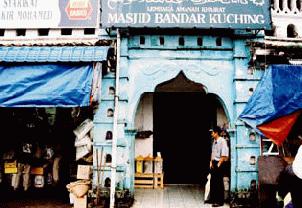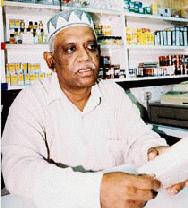|
Masjid India,
Kuching
Mosque with a
Chequered History
By Zora Chan
KUCHING: Unlike many mosques in the city, the Masjid Bandar Kuching or
Masjid India (Indian Mosque), the oldest in the State, is inconspicuous. It’s
sandwiched between busy shop houses at India Street and Gambir Street.
To enter the mosque, you traipse through a narrow lane at India Street, or
through its main entrance at Gambir Street. Both lanes are between shops. It’s an
aromatic grand entrance for the visitor who gets a whiff of the spices on sale.
Built in 1837, the mosque was built by Indian Muslims who originated from
southern India. Originally, the walls and roof was made of nipah palms. In 1876, belian
wood planks replaced the nipah palms walls. Later, the floor was cemented.
According to a mosque committee member known only as Kudpudeen, the
mosque covered an area of 16,004 square feet.
Officially, it’s now known as the Masjid Bandar Kuching.
“The name was changed to Masjid Bandar Kuching sometime in the 1960’s,
but still the mosque is locally known as Masjid India and sometimes Masjid Tambi because
those who came to pray here were mainly Indian Muslims in the olden days,” he
said.

|
 |
SANDWICHED...The
main entrance which faces Gambir Street, between busy grocery stores |
KUDPUDEEN.....
a convenient place for workers in the area, and for shoppers |
“Other than the Indian Muslim community, at that time when there was
no road transportation yet, the Malay Muslims which we called the ‘orang laut’
(people of the sea) because they lived by the sea in Lundu, Santubong, Pusa and Beladin,
also came to the mosque to pray and rest.”
Kudpudeen added that they would berth their sampans by the Sarawak River
(near the Gambir Street wet market) and visit the mosque for prayers. Sometimes, they
lodged in the mosque before returning to their villages. To this day, Masjid India
provides shelter to tired travellers.
Being in the heart of the city, it is a convenient place for Muslims
working in the area and shoppers.
Kudpudeen says four generations of his family have worshipped at the
mosque. On Fridays, the congregation swells to about 1,500. On other days, some 400 gather
for prayers.
“It is always full with people on Friday afternoons and if you are
late, you’ll have to stand outside,” said Kudpudeen.
He said, the mosque also started the first religious school in the state
back in the 1940’s. The Madrasah Islamiah remains in operation.
Funds for maintaining the mosque come from rent collected from 23
neighbouring shops. These are owned mainly by Indian Muslims who sold groceries, spices,
cloth and books. Two Chinese shopkeepers also operate their businesses in the area. These
family businesses have been handed down through the generations.
Added Kudpudeen, “We have a committee called the Lembaga Amanah
Khairat which administrates the Masjid India, and whatever funds we collected will be used
to maintain the mosque.”
Kudpudeen noted that although the mosque is the oldest in the State, few
youths know about it.
The time for prayers is marked by the sounding of a drum, known locally as
the ‘bedok’. Kudpudeen fretted over the condition of the drum. It’s been in
use for 50 years, and no one has acquired the skills to repair it.
Source: Borneo Post
BACK
TO LEISURE PAGE
|
